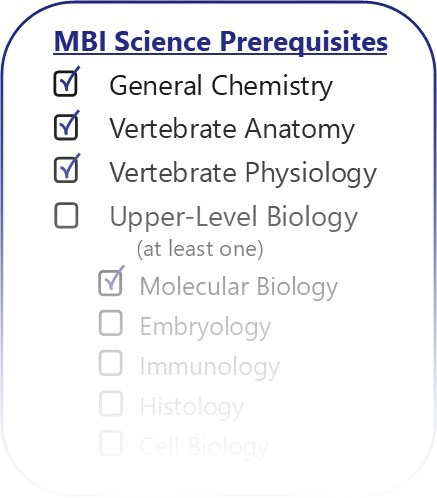MBI Science Prerequisites
The first-year Medical and Biological Illustration students take the same Human Anatomy course as the Hopkins Medical students. The same lectures, labs, lab presentations and exams! This is likely one of the toughest courses in medical school anywhere in the world. Because the Hopkins Human Anatomy course starts within the first month of classes, it is essential that incoming students enter our program with a firm foundation in preparatory sciences.
To help best prepare applicants for the challenging sciences taken during our program, the Admissions faculty have selected 4 sciences that will offer incoming students the minimum preparation for success at Hopkins. All applicants are required to complete all 4 prerequisite sciences prior to enrollment in the program (early August). We recommend having all science prerequisites completed and graded prior to submitting your portfolio by January 10th. Applicants with a strong science background, e.g. science majors or applicants with 5 or more additional sciences, can have 1 science prerequisite in-progress by the January 10th due date.
Taking more than the minimum can offer better preparation and a better knowledge base for a future career in medical illustration.
General Chemistry
A foundation in the fundamental principles of chemistry including atomic and molecular structure, the periodic table, stoichiometry and chemical equations, gas laws, chemical equilibrium, acids and bases, and elementary thermodynamics are helpful preparation.
Vertebrate Anatomy
with dissection lab
A strong Vertebrate Anatomy lecture class combined with a hands-on dissection lab is essential preparation for the science classes taken during the program at Hopkins. Learning anatomical terminology and scientific names is encouraged.
Artists who have hands-on experience with dissection develop a tactile memory for the different organs, textures, locations and inter-relationships that will inform their knowledge of those structures. However, many colleges and universities are eliminating hands-on dissection labs and transitioning to prosection labs (dissection performed by faculty or lab techs), plastinated specimens, plastic models or virtual dissections. These alternate labs do not offer the same tactile knowledge of the various structures and interconnections as experienced in hands-on dissection labs. A plastinated specimen, while good for rote memory, will not move, look or feel the same – a key aspect for an accurate illustration. It is vital to search for a college or university that continues to offer a hands-on dissection lab to best prepare for a future in medical illustration.
Vertebrate Physiology
Knowing how these various structures function is equally important preparation. Understanding the complex processes of the cells, tissues, and organ systems of the body is the foundation of medical research. Look for a class that includes organ systems physiology.
Upper-Level Biology
5 Choices: Molecular Biology, Cell Biology, Embryology, Immunology, or Histology
Not every university or college offers the same courses. Because of this, the faculty have a short list of 5 courses they believe will offer applicants a chance to prove their ability to achieve high marks in a tough science, like those taken during our program. In addition, these courses will further prepare applicants for the concepts they will later illustrate in the program and profession. Each should be an advanced course typically taken in the last years of undergraduate study (i.e. junior / senior level coursework). Applicants need to take at least one of these five options for this prerequisite; taking more will better prepare applicants for the profession.
With medical research increasingly focused on molecular and cellular structures, medical illustrators are illustrating these concepts more and more. A firm foundation in this level of science will help when communicating with clients and creating illustrations. Each of the above Upper-Level sciences will offer a solid foundation.
Key topics covered in these courses might include:
- Biochemical and physiological mechanisms underlying cellular function.
- Properties of cells which make life possible and mechanisms by which cells provide energy, reproduce, regulate and integrate with each other and their environment
- DNA; RNA; transcription and translation; protein synthesis
- cell organelles, cytoskeleton, transport, and cycle control
- cell membrane and membrane dynamics
- chromosomal organization; epigenetics; etc.
If you have additional questions, don’t hesitate to contact us – [email protected] or Request Information.
More posts on the Admissions Blog.

